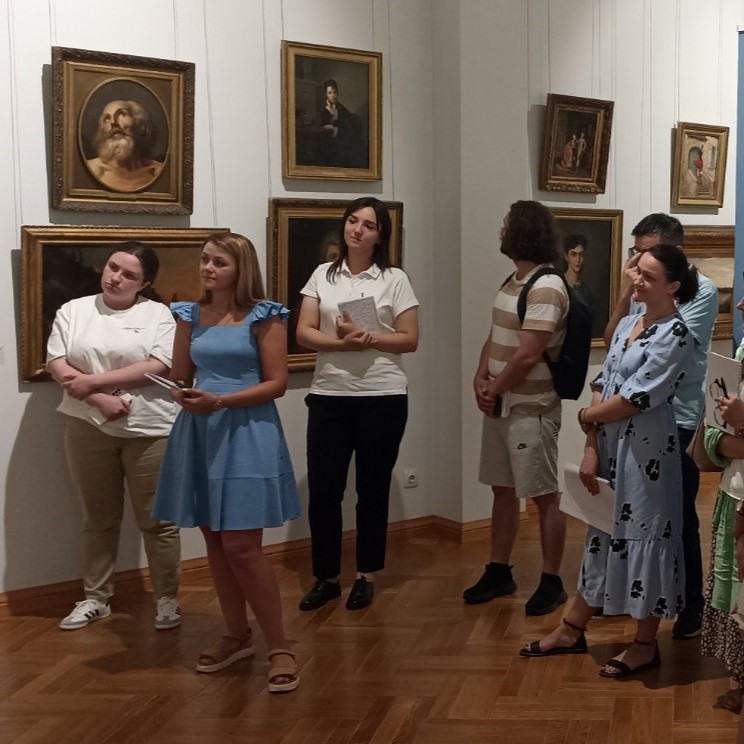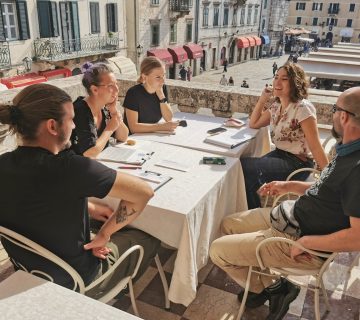Chisinau, Moldova’s capital, was the setting for an IE Certified Interpretive Guide (CIG) course in July 2024.
During the hot days of summer, Chisinau hosted an Interpret Europe CIG course, supported by the USAID Rural Competitiveness and Resilience Project (RCRA), in partnership with the Ministry of Culture, the National Museum of Ethnography and Natural History, and the National Art Museum of Moldova. This course, the first to be delivered in Republic of Moldova, represents an innovative approach to cultural heritage interpretation, integrating knowledge and interdisciplinary methods from the social sciences, humanities, and communication fields. Harmoniously combined within this heritage interpretation method, the training opens new perspectives for the development of domestic tourism in Moldova, targeting guides from museums, nature reserves, travel agencies, wineries, as well as cultural researchers of material and immaterial culture – all with an important mission of effectively interpreting our cultural heritage. Certainly, it won’t be long before the results are visible in the development of tourism in our country!
The course was delivered by Vanessa Vaio, Interpret Europe’s Country Coordinator Italy, and an expert in heritage interpretation with over 28 years of experience in the field. The course participants were coordinated by Mariana Mischevca, Quality Systems and Workforce Development Manager at the Rural Competitiveness and Resilience Project in Moldova, implemented by Chemonics International, Inc.
The course material and Heritage Interpretation Manual is designed for interpretive guides to be used throughout Europe. Using tested exercises to be completed by guides on their own and with suggestions for self-evaluation and peer coaching, the manual provides an informational support that helps guides and museum professionals improve their skills and enhance their abilities to present the heritage in their collections. We can find information about the four aces; how interpreters promote stewardship of heritage and can turn phenomena (cultural assets) into experiences; interpreters change roles; interpreters align facts with central ideas (themes); changing formations; carefully using props during a tour; accepting interference; overcoming barriers; expanding the horizon of the theme they present to tourists; highlighting the relevance of sustainability; connecting phenomena; planning and recalling steps; evaluating an interpretive tour; opening and closing, how to proceed?, etc. The guide also presents models, appendices of an interpretive discussion, an example form, and an evaluation form conducted by a critic, expert in interpretive tours.
The course had 18 participants, including tourism guides and museum professionals, aiming to strengthen the interaction methods between tourism professionals and museum guides with the public, transforming information into memorable experiences through storytelling. The course included representatives from various educational, cultural, and tourism institutions in the Republic of Moldova: the National Museum of Romanian Literature, the National Museum of Ethnography and Natural History, the National Museum of History, the National Art Museum of Moldova, Moldova State University, ‘Ion Creanga’ State Pedagogical University from Chisinau, the National Association for Inbound and Domestic Tourism, Cricova Winery, Mileștii Mici, Orheiul Vechi Cultural-Natural Reserve, Wine Tours Moldova, Tourism Journey Moldova, National Tourism Office, and Go Adventure.
Here we share some impressions from course participants:
”Thanks to this course, we, the participants, learned new techniques for presenting and interpreting the subject related to national heritage to tourists”
“[Our trainer] presented us with broader horizons in the field of interpretive guiding to reach the hearts of tourists who visit our places”
“Course participants acquired various techniques for organising interpretive activities and presentation techniques to create bridges between landscapes, people, and history, revealing hidden stories and creating unique experiences about the tangible and intangible heritage of the Republic of Moldova”.
Course participants are now completing their homework – conducting a guided tour based on the methods and techniques studied – before they receive their Interpret Europe certificate to become a Certified Interpretive Guide (CIG). We thank all the organisers of this important course for guides in natural and cultural heritage locations in the Republic of Moldova, including natural parks, zoos and botanical gardens, castles, wineries, rural locations, and museums. We hope that these concepts will be appreciated and successfully developed further.
Cristina Caterev is the head of the Heritage, Documentation, Conservation Section at the National Museum of Romanian Literature, Chișinău (www.mnl.md). You can get in touch with her at: cristina.mnlmk@gmail.com.
Adrian Dolghi is a researcher and guide at the National Museum of Ethnography and Natural History, Chișinău (https://www.muzeu.md). You can get in touch with him at Addolghi@gmail.com.
To cite this article: Caterev, Cristina & Dolghi, Adrian (2024) ‘Training guides for innovative interpretation of cultural heritage‘ in Interpret Europe Newsletter 3-2024, pg.10-11.
Available online: PDF-Newsletter_2024_3.pdf




